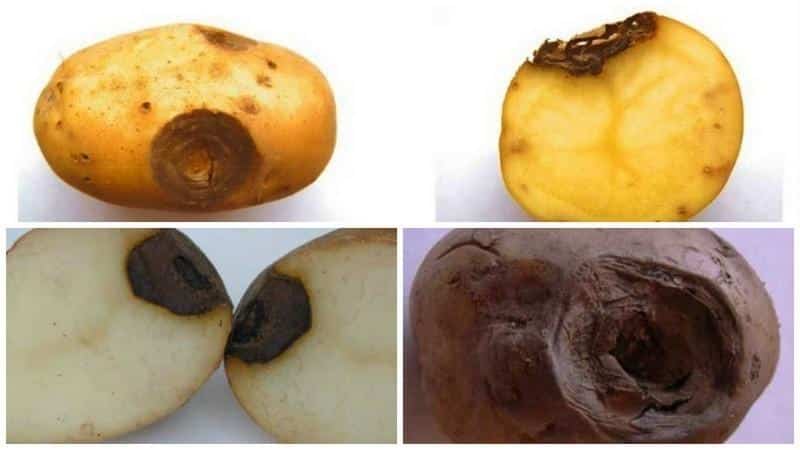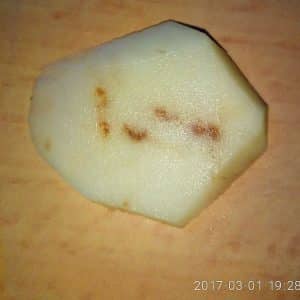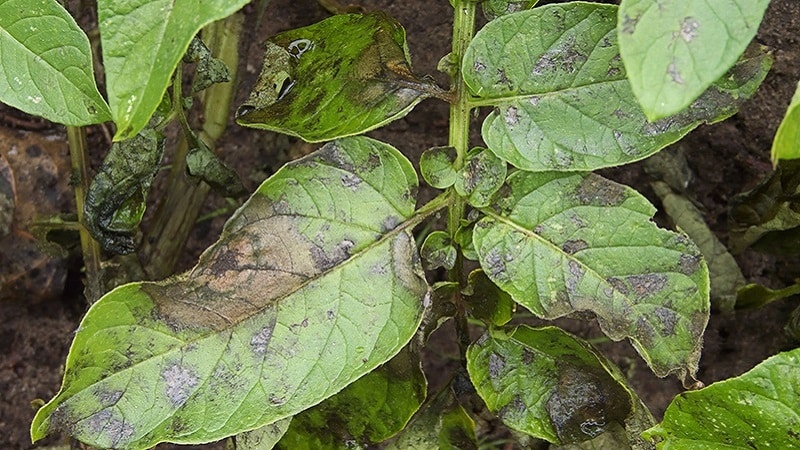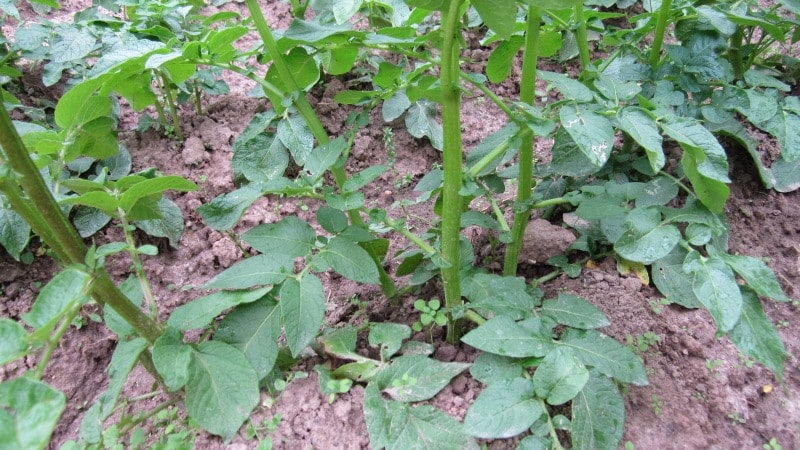Why are there spots on potatoes: measures to combat glandular spot and other diseases
Gardeners often notice spots of different shapes, colors and sizes on potatoes, which spoil not only the appearance of the plants, but also productivity. Such marks can be signs of blackleg, scab, glandular spot, Alternaria blight, or a feature of the variety. To get rid of the cause of the lesion, it is important to know what kind of disease causes spots on tubers and how to prevent it.
Description of diseases
Spots on potatoes do not always mean they are spoiled. Tubers lose their taste and become unfit for food only when seriously damaged.

Rust spots
Rust indicates the presence of glandular spotting of potatoes. The disease occurs due to non-compliance with agricultural practices, drought, and high air temperatures.
By the way! Some agronomists are inclined towards the viral etiology of potato spot, but healthy bushes often grow from diseased tubers, which contradicts this version.
Brown
Blackleg is a bacterial disease from which it is difficult to protect the crop. During frosts, microorganisms feed on the roots remaining in the soil and survive until the next season. To avoid this, the beds are carefully weeded. Before the next planting, carefully inspect the tubers.
Signs of infection:
- presence of brown spots;
- dark gray skin;
- a liquid with an unpleasant odor that pours out when pressed.
If contaminated vegetables get into storage, the entire harvested crop will suffer.
Black
With melanosis of potatoes, dark shapeless spots become noticeable, which turn black when cooked. To avoid this, observe the conditions for harvesting, transportation and storage of the crop.
If small black spots appear on potatoes, a common cause is the fungal disease Alternaria. It occurs due to violation of crop rotation rules, planting crops next to other nightshades. Mushrooms reproduce by spores and gradually infect all bushes. Potassium and phosphorus fertilizing will significantly strengthen the plantings.
Reds
Housewives sometimes notice red spots on them when cleaning tubers, thinking that this is a sign of disease. In fact, such inclusions are safe and are not symptoms of damage. They arise due to oversaturation of the soil with aluminum and iron, deficiency of potassium and phosphorus.
There are varieties for which redness is a natural feature.
Reference! The pulp of Krasnopolskaya potatoes has red spots and veins. This happens due to flavonoids - plant pigments responsible for color. During heat treatment, the spots fade and become almost indistinguishable. Tubers with such characteristics are suitable for consumption.
Purple
Purple spots on potatoes are a feature of some varieties (Vitelot, Vzryva, Lilac) or their hybrids. It happens that one part of the peel is brown and the other is purple. Gray or black spots are signs of blackleg or Alternaria.
Varieties with purple pigmentation are fastidious in care and defenseless against scab and Colorado potato beetle. When propagated by eyes, the tubers become smaller and the crop becomes wild.It is difficult to grow, but lilac puree or fries will attract the attention of guests.
White
Light spots indicate silver scab. The fungus parasitizes the peel. The disease occurs due to non-compliance with agricultural cultivation techniques. In hot weather, when tubers are set, silver spot reaches its peak.
Attention! The disease often develops in loamy or sandy soil. During harvest, the tubers are carefully inspected, and the affected specimens are burned.
Signs
Any disease has distinctive symptoms:
- Iron spot — on the section of the tuber, the peripherality of the lesion is visible. Rust spots come in different sizes: from 1 mm to 2 cm. Occurring on the peel, the disease gradually penetrates into the pulp. Small spots merge into one big one. Potatoes are not is rotting, but remains tough during heat treatment. Tubers left for planting do not spoil and are stored until the next season. They grow into healthy plants with proper care.

- Blackleg - leaves, stems and tubers become covered with brown spots. The potatoes crack, darken, and when pressed, exude a foul-smelling brown liquid that contains large amounts of bacteria. Infected bushes are burned.
- Melanosis - the tubers are covered with dark spots that turn black when cooked.
- Alternaria blight - leaves are covered with brown spots. The spores are carried by the wind and settle on the upper parts of the bush. Within a few weeks, the fungus reaches the tubers and infects them, leaving black marks.
- Silver scab — the disease becomes noticeable when the mycelium is sufficiently developed. Dark brown spots appear on the peel. With severe damage, dents are formed, covered with a silvery-white coating.
Timely detection of symptoms will help to take timely measures and preserve the harvest.
Causes
The problem has different origins, but a common cause of its occurrence is errors in care:
- Iron spot — the appearance of the disease is affected by a deficiency of phosphorus and soil potassium, excess aluminum or abnormal summer heat.
- Blackleg — the infection is spread by insects, especially the Colorado potato beetle. If infected seed is planted in the beds, the disease will actively progress. Favorable conditions for the development of bacteria are high humidity and heavy soil.
- Melanosis - occurs due to mechanical damage to tubers during transportation, too early harvest, vegetable storage in heat for more than 8 weeks, lack of potassium in the soil or oversaturation with nitrogen fertilizers.
- Alternaria blight - worsens in hot, dry weather. Young shoots are the first to suffer. At an advanced stage, spores penetrate the tubers, but more often infection occurs during harvest through the soil. Fungi love to parasitize mid- and late-season potato varieties. One of the reasons for plant damage is low levels of minerals in the soil.
- Silver scab — mushrooms develop at high soil moisture and heat, when a greenhouse effect is created.

Control measures
There are different ways to counteract diseases: traditional, chemical and biological.
Folk
These are the simplest control methods available to every gardener:
- To protect seed tubers from diseases, use a pale pink solution of potassium permanganate. Vegetables are immersed in a hot bath (+60°C) for 20–30 minutes. When symptoms of damage appear, the bushes are treated with the same solution.
- To protect the crop from silver scab, planting material is treated with a 1.5% solution of boric acid. Bird droppings dissolved in water are added to the holes (1:15).
- For iron spotting, the soil is saturated with lime, nitrogen or phosphorus, depending on which element is missing.
- At the first symptoms of Alternaria blight on the leaves, the bushes are sprayed with a 1% solution of Bordeaux mixture 4 times a day.
Chemical
If folk remedies are ineffective or the disease is advanced, chemical agents are used:
- At the first signs of Alternaria, the bushes are treated with Arceride for 7 days.
- To prevent silver scab, plants and planting material are sprayed with a solution of FitoPlus or Fundazol.
- The drugs “Bravo”, “Maxim”, “Ridomil” help against any type of fungus.
Biological
These methods are less dangerous for the potatoes themselves:
- Planting green manure (mustard, wheat, radish, oats, legumes) in neighboring beds prevents the spread of Alternaria and blackleg. The soil is sprinkled with charcoal, the plants are treated with copper oxychloride.
- Spraying the tubers before planting with Baktofit or Planriz will protect the plants from silver scab and other fungal infections.
- For glandular spotting, mineral fertilizers with calcium are applied to the soil.
Prevention measures

Some diseases are incurable, but their development is easy to prevent:
- It will not be possible to save potatoes infected with scab, but crop rotation, acidic fertilizers and regular watering will prevent its occurrence.
- To prevent iron spotting from occurring, nitrogen fertilizers are added to the soil, green manure is planted, and on hot days the sprinkling method is used.
- To prevent blackleg, tubers are not planted in clay soil.The crop is not grown in one place for more than 3 years. A good predecessor is legumes.
- Timely implementation of agrotechnical measures will reduce the risk of melanosis: per 100 g of soil in the garden bed, the optimal content of potassium is 15-16 mg, therefore, in soils depleted of it, the deficiency is compensated for by fertilizing.
- To prevent Alternaria, tubers are treated with a solution of copper sulfate, Bordeaux mixture or fungicides before planting. Having noticed dangerous symptoms 2-3 weeks before harvest, the entire tops mowed down and burned. This will save the vegetables, but if some of them are contaminated, they are destroyed.
Proper tillage of the soil and saturation of it with essential minerals will ensure a high-quality harvest.
Tips and tricks
Some techniques that will help you get a rich potato harvest and protect your plantings from diseases:
- if the territory of the summer cottage is small and does not allow frequent replanting, the land is not fertilized with manure;
- with a high alkali content, the soil is acidified with ammonium at the rate of 2 tbsp. l. per bucket of water (during the flowering period you will need 500 ml of solution for each bush);
- If, after harvesting, the area is sown with green manure, the land will recover faster and be enriched with useful substances.
Conclusion
The quality and volume of the future harvest depend on the health of the tubers left for planting. To protect plants from diseases, they disinfect the seed, follow the rules of crop rotation, promptly replenish the soil with minerals, do not over-moisten it and do not forget to water the bushes. After harvesting, the vegetables are carefully inspected, all plant debris with roots is removed and destroyed from the ground.